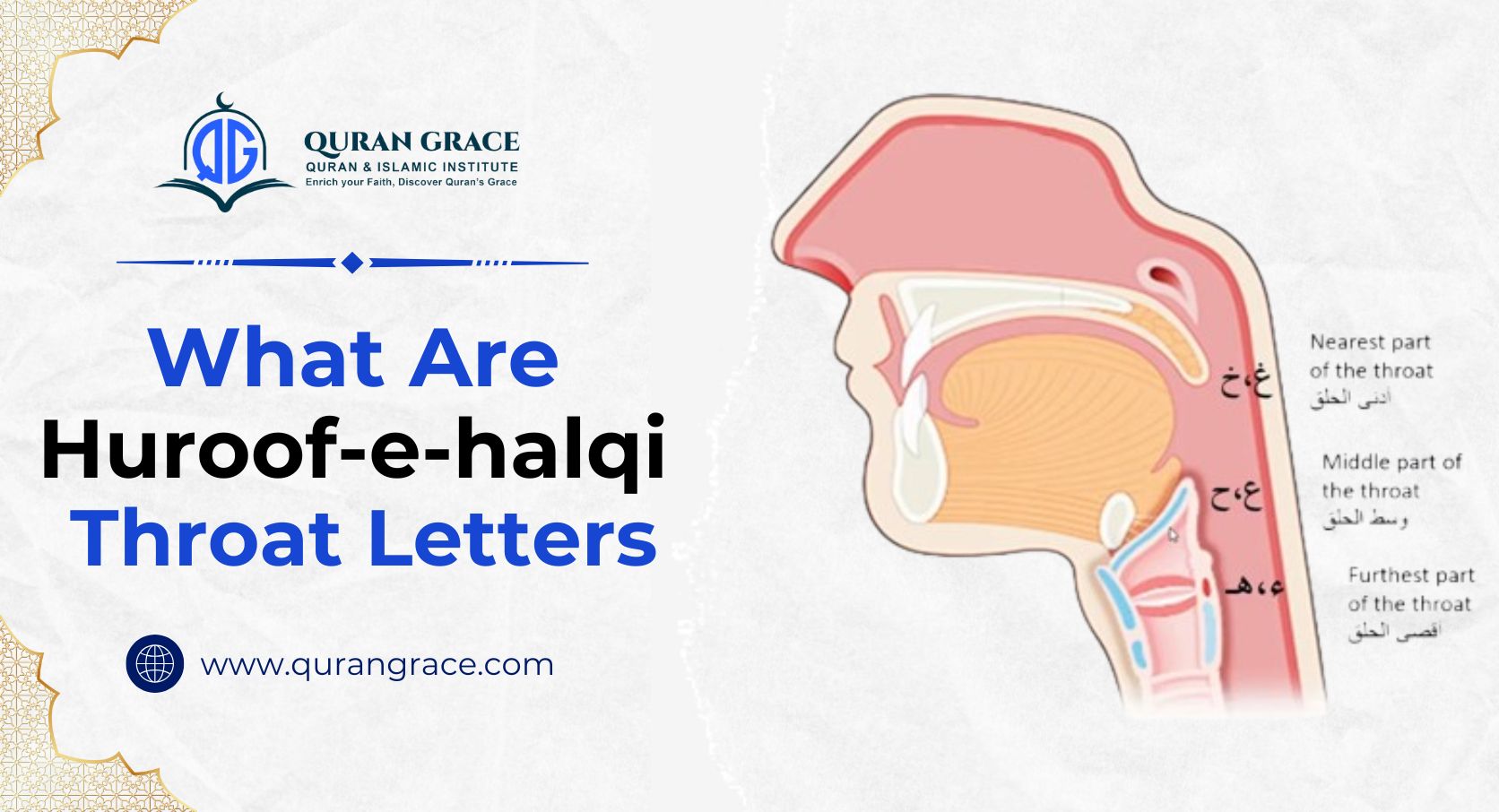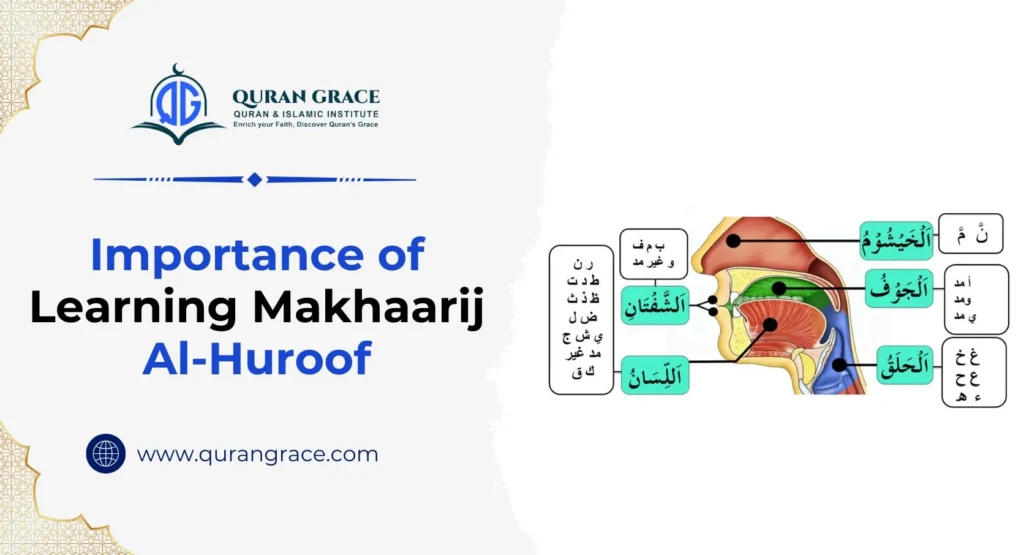Tajweed is essential for accurate Quran recitation, and to master all the basic quran Tajweed rules, you need to learn Huroof-e-halqi accurately. Understanding Halqi (throat) letters is crucial for mastering the correct pronunciation of various Arabic characters, which is particularly important in the context of Quranic recitation. We will delve into the detailed explanation of Huroof-e-halqi to make it easy for students to understand this topic.
Table of Contents
ToggleWhat does Huroof-e-Halqi mean?
The Arabic word for “throat” is Halq and huroof means letters. So, huroof-e-halqi are the letters that are articulated from the throat. Alongside Halq, the other articulation points include the tongue, lips, nasal cavity, and inner mouth. Halq itself is divided into three specific sections, each playing a vital role in the production of certain Arabic letters, particularly the throat letters. Understanding these categories is essential for mastering proper pronunciation in Arabic.
What are the Letters of the Throat in Tajweed?
The letters referred to as “Hurruf-e-halqi” are articulated from specific areas in the mouth. These letters play a crucial role in the Arabic language, and their correct pronunciation is essential. Mispronouncing Huroof-e-Halki can alter the meanings of Quranic words, potentially changing the intended message in the text. Therefore, understanding and properly articulating these letters is vital for accurate communication and comprehension of the language.
Six Huroof-e-halqi in Tajweed:
- ء (Hamzah)
- ه (Haa)
- ع (Aien)
- ح (Haa)
- غ (Ghaien)
- خ (Khaa)
Each of these letters is unique in its articulation, meaning, and sound, and they are classified based on the part of the throat from which they originate.
3 Main Sections of Throat letters
Three portions make up the throat, and each section represents a different point of articulation. These sections are:
1. Adna Halq (Lower Throat Letters)
- Letters: ء (Hamzah) and ه (Haa)
- Explanation: This region is located at the base of the throat, closest to the chest. Haa and Hamzah both come out of the lower throat.
2. Wast Halq (Middle Throat Letters)
- Letters: ع (Ayn) and ح (Haa)
- In the middle neck, the letters Ayn and Haa are produced. They must be spoken a bit more softly than the letters from Adnal-Halq.
3. Aqsa Halq (Upper Throat Letters)
- Letters: غ (Ghayn) and خ (Khaa)
- Explanation: Ghayn and Khaa are articulated in the upper throat, which is the area nearest to the mouth. When compared to other letters, these sounds frequently have a more noticeable resonance.
How to Pronounce These Letters?
ء (Hamzah)
- Point of Articulation: Adna Halq, lower neck.
- Sound: It is produced by a quick glottal stop.
- Features: Hamzah is voiceless, which means that its vocal cords do not vibrate when it is articulated.
ه (Haa)
- Articulation Point: Adna al Halq, lower neck.
- Sound: Resembles a breathy “h” sound.
- Features: Haa requires the reciter to exhale air while maintaining a steady throat constriction.
ع (Ayn)
- Articulation Point: Middle Throat (Wast Halq).
- Sound: Produced with a guttural sound that has no English translation.
- Features: Non-native speakers may find it challenging to produce the guttural sound of Ayn because it necessitates a contraction in the middle throat.
ح (Haa)
- Articulation Point: Wast Halq, or middle throat.
- Sound: A powerful, aspirated “h” sound that differs from the English “h” sound found in terms like “hat.”
- Features: The voice requires controlled airflow to produce a strong, clear voice free of vocal cord vibration.
غ (Ghayn)
- Articulation Point: Aqsa Halq, upper neck
- Sound: Guttural, like the French “r” in “Paris.”
- Features: To produce a resonant voice, Ghayn needs the vocal cords to vibrate.
خ (Khaa)
- Articulation Point: Aqsa Halq, upper neck
- Sound: It sounds like the “ch” in the German word “bach” or the Scottish word “loch.”
- Features: This breathy sound is produced without the use of the vocal cords.
4 Rules for Pronouncing Throat Letters
When it comes to the pronunciation of Huroof-e-Halq, or Throat Letters, certain rules are essential for achieving accuracy in Quranic recitation.
-
Makharij (Articulation Points)
Proper pronunciation begins at the correct articulation points located in the throat. Mispronunciation can alter the meaning of the words altogether. There is a dire need to learn and practice the makharij al huroof from a qualified and certified Tajweed teacher or join an advanced Tajweed course at Quran Grace.
-
Sifat (Characteristics)
Each Huruf-e-Halki letter possesses unique characteristics, such as breathiness, intensity, or softness. Maintaining these qualities is vital for accurate recitation, as each letter has distinct vocal traits that contribute to the overall sound. It is necessary to understand the sifaat of all throat letters when pronouncing them. It will bring excellence to your Tajweed.
-
Tafkheem and Tarqeeq
The pronunciation of certain sounds is influenced by tafkheem (thickness) and tarqeeq (thinning). For instance, the letters Hamzah and Haa are pronounced with a lighter quality, whereas Ghayn is pronounced with a thicker, more pronounced sound due to its Tafkheem quality. So, a student must know the lightness and heaviness of the letters while articulating them.
-
Training and Practice
Continuous practice under the guidance of a qualified Arabic teacher is crucial in Tajweed courses. This approach helps reciters familiarize themselves with the proper throat movements, which can be particularly challenging for those who are non-native speakers.
By adhering to these principles, individuals can enhance their Quran recitation and ensure clarity and correctness in their pronunciation.
How to Practice Huroof-e-Halqi?
-
Get to Know the Articulation Points
It’s essential to focus on the articulation points when practicing throat letters. Be mindful of the three throat sections involved in producing these sounds. Use a mirror or an animated picture of the mouth to see exactly how to articulate a letter. Try putting a finger on the specific articulation point when uttering the letter to see if you are uttering from the correct place.
-
Listen and Imitate the Reciters
Record your recitations and listen to them carefully. Compare your performance with that of skilled Qaris to identify areas for improvement and refine your technique. Try this tip whenever you open the Qaida for revision. The more you practice, the better your Tajweed will be.
-
Establish a Routine
Consistent practice is key to strengthening the muscles in the throat. Over time, this regular engagement will lead to a more natural feeling of articulation. Either practice your Tajweed early in the morning or before going to bed at night. Do not miss your practice session.
-
Get Help From a Tutor
Collaborate with an egyptian quran teacher online who can provide personalized feedback on tajweed. This guidance is crucial for correcting errors and improving overall recitation quality. Record your Tajweed while reciting a verse or a surah, and then ask your teacher to check if you are on track.
Conclusion
Pronouncing Huroof-e-Halqi correctly and learning the science behind it will help you properly recite the Quran with Tajweed and preserve Allah’s words in their intended form, ensuring a deeper, more accurate spiritual connection. Join a free trial online tajweed classes at Quran Grace to see how native Egyptian tutors make non-Arab students learn Tajweed efficiently.








